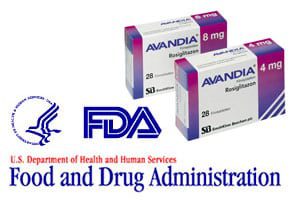
In an unprecedented move, the U.S. Food and Drug Administration is reopening the matter involving Type 2 diabetes drug, Avandia, which is marketed by GlaxoSmithKline. Avandia belongs to a class of diabetes drugs called thiazolidinediones that lower blood sugar by decreasing insulin resistance. Since November 2007, Avandia’s United States label has included a black box […]
 In an unprecedented move, the U.S. Food and Drug Administration is reopening the matter involving Type 2 diabetes drug, Avandia, which is marketed by GlaxoSmithKline.
In an unprecedented move, the U.S. Food and Drug Administration is reopening the matter involving Type 2 diabetes drug, Avandia, which is marketed by GlaxoSmithKline.
Avandia belongs to a class of diabetes drugs called thiazolidinediones that lower blood sugar by decreasing insulin resistance. Since November 2007, Avandia’s United States label has included a black box warning detailing its association with heart attacks. The black box was added after Dr. Steven Nissen of the Cleveland Clinic published a study showing that patients taking Avandia had a 40 percent increase in the risk of cardiovascular disease. Since 2007, more evidence of Avandia’s heart risks has accumulated and thousands of lawsuits have been brought against GlaxoSmithKline over the blockbuster drug. In 2010, the FDA placed severe restrictions on sales of Avandia after determining its heart risks outweighed its benefits.
Today, Avandia is the drug of last resort for those people diagnosed with Type 2 diabetes who are so ill that the for heart attack is considered a risk worth taking, according to The New York Times.
The agency seeks an opinion from a panel of experts concerning whether Avandia’s restrictions should be reconsidered. This is just one of some options put before the committee, said The Times, but that would be a massive policy reversal.
Dr. Nissen has long said that Avandia is too dangerous for use in diabetes treatment and is among a group of experts that says that the FDA’s revisiting of this drug is not about protecting patients, but about saving face, according to The Times. “The efforts to whitewash this entire affair is really an unacceptable misuse of their regulatory role,” Dr. Nissen told The Times, adding that he would be “horrified” if the panel recommends removal of current restrictions. “The evidence against this drug is overwhelming,” he said.
Dr. Janet Woodcock, the FDA’s drug official, said this week’s two-day meeting is being convened to look at a review she requested in 2010 of a prior Glaxo clinical trial. “I made the decision last time about Avandia, and it’s not that it was an open-and-shut case,” she told The Times. “What we’re trying to do here is resolve that uncertainty as much as we can with all the available data.”
“It’s turning back the clock,” said Dr. Clifford J. Rosen, director of clinical and translational medicine at the Maine Medical Center in Portland. Dr. Rosen led the 2007 advisory committee on Avandia. “I have no idea why they would revisit this issue. It’s a done deal.” Dr. Nissen, who did not serve on the 2010 panel as been denied his request to speak at this week’s meeting.
Daniel Carpenter, a Harvard political scientist who studies the agency said that the FDA’s request for reanalysis “smacked of venue shopping.” Carpenter pointed out that the move is odd given that one of its own scientists, Dr. Thomas Marciniak, previously conducted an analysis of the trial, finding a number of mistakes that favored Avandia, according to The Times.
Glaxo previously announced that it was paying $3 billion to settle U.S. criminal and civil investigations into whether it marketed the diabetes drug and other medications illegally and agreed to cease marketing Avandia as a treatment for Type 2 diabetes, respecting the demands of the FDA and other regulatory agencies worldwide, which all then believed the drug carried a risk of causing heart attacks and stroke more than other available treatments. Glaxo never noted those risks in any clinical data; however, those filing lawsuits believe the company had been presented ample evidence of those risks.
Glaxo was also the focus of a federal investigation since 2004 over alleged illegal marketing and suppression of negative evidence on the side effects of Avandia and several other of its top-selling drugs. In fact, a previous Bloomberg News report cited a 2007 incident in which a University of North Carolina professor told U.S. officials he was pressured by Glaxo to mute his criticisms of Avandia, specifically related to its link to heart attacks and stroke, ever since the drug was first introduced in America in 1999.


